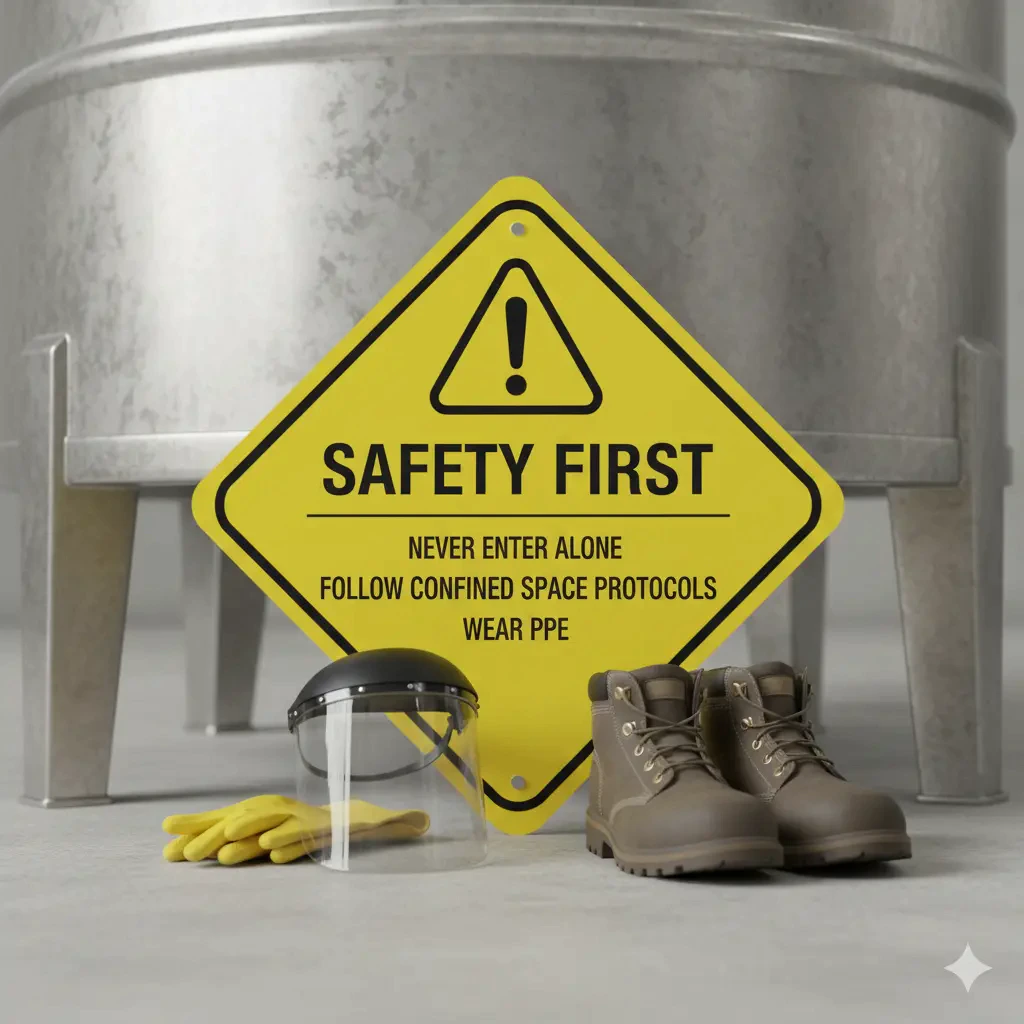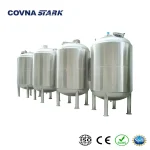A stainless steel water storage tank is a serious investment in water quality and system reliability. But like any piece of critical equipment, it needs routine maintenance to keep delivering safe, clean water over its entire service life.
At Stark Water, we design and manufacture industrial-grade stainless steel water tanks for demanding applications— so we see the good, the bad, and the ugly when it comes to tank cleaning and maintenance.
Many users ask us:
- “How to clean stainless steel water tank surfaces without causing corrosion?”
- “What is the safest way to clean a water storage tank and disinfect it for drinking water?”
In this guide, we share our proven 7-step method for how to clean a stainless steel water storage tank safely and effectively. You will learn:
- Essential safety precautions (especially for large industrial tanks)
- The right tools and materials to use
- A detailed step-by-step cleaning and disinfection process
- How often to clean your tank based on your water source
- When it may be more cost-effective to upgrade to a new tank design
Why Bother Cleaning a Stainless Steel Tank?
There is a common misconception that stainless steel is “self-cleaning” because it is smooth, hygienic, and corrosion-resistant. While stainless steel is an excellent material for water storage, it does not eliminate the need for regular cleaning.
Even in high-quality stainless steel tanks, you can still get:
- Sediment build-up – sand, silt, rust from piping, and mineral scale settle at the bottom.
- Biofilm and algae growth – especially if the tank is outdoors, exposed to sunlight, or using well/surface water.
- Changes in taste or odor – stagnant water, residual disinfectant, or organic matter can affect taste.
- Hidden corrosion or damage – small leaks, pitting, or weld issues may only be found during visual inspection.
Routine cleaning and disinfection:
- Helps maintain consistent water quality and taste
- Prevents sediment and scale from clogging lines, valves, and fixtures
- Provides an opportunity to inspect welds, manways, nozzles, and internal fittings
- Supports regulatory and hygiene requirements for potable water storage
- Extends the service life of your stainless steel water tank
If your tank is critical to production or drinking water supply, cleaning is not optional—it is part of responsible operation and water safety.
Critical Safety First: Before You Start
This is the most important section of the entire guide. Cleaning a water tank—especially a large industrial or municipal tank—can involve real hazards, including confined-space entry, chemical exposure, and slips or falls.
1. Confined Space Warning (Industrial Tanks)
Large water tanks are usually classified as confined spaces. Entering a confined space without proper training, equipment, and supervision can be fatal.
Never enter a large tank alone.
For industrial or municipal tanks, you must:
- Follow your company’s confined space entry program
- Use a trained attendant outside the tank
- Perform air monitoring for oxygen levels and hazardous gases
- Ensure forced ventilation and emergency rescue plans are in place
Many public health agencies warn that storage tanks should only be entered by qualified professionals. If you are not trained or do not have the correct equipment, do not enter the tank—hire a qualified tank cleaning contractor instead.
2. Physical Safety
Tank interiors and surrounding areas become extremely slippery when wet. To avoid falls and injuries:
- Wear non-slip safety footwear
- Use stable ladders and platforms with guard rails where needed
- Keep hoses and cables organized to avoid tripping hazards
3. Electrical Safety
If pumps, heaters, mixers, or level sensors are installed on your stainless steel water tank:
- Isolate and lock out/tag out (LOTO) electrical circuits before cleaning
- Never run powered equipment in a partially drained tank unless the manufacturer explicitly allows it
4. Chemical Safety
When you disinfect the tank with chlorine or another sanitizer:
- Use unscented household bleach or a disinfectant that is certified for potable water where required
- Wear chemical-resistant gloves, goggles, and boots
- Follow the disinfectant manufacturer’s Safety Data Sheet (SDS) and instructions
For potable water applications, always check your local health department or water authority guidelines for approved disinfectants and dosage.

Tools and Materials You’ll Need
Preparing everything in advance makes the cleaning process smoother and faster.
Personal Protective Equipment (PPE)
- Safety goggles
- Chemical-resistant gloves
- Non-slip waterproof boots
- Protective clothing or coveralls
Cleaning Tools
- Soft-bristled nylon brushes
- Non-abrasive pads (absolutely no steel wool or metal scrapers)
- Long-handled brushes for tall walls and roof
- Pressure washer or high-pressure hose (water only)
Water Removal Equipment
- Submersible pump (for draining residual water)
- Wet/dry vacuum (for sediment and sludge)
- Buckets, mops, and absorbent cloths
Cleaning and Disinfection Supplies
- Mild, NSF-approved tank cleaning solution or food-grade detergent
- White vinegar (for light mineral deposits)
- Unscented household bleach or other potable-water-approved disinfectant
- Clean potable water for rinsing
Important: Avoid harsh acids or chlorides on stainless steel unless they are specifically approved for your tank design. High chloride concentrations can cause pitting corrosion if misused.
Step-by-Step Guide: How to Wash Your Water Tank (7-Step Method)
This is our proven 7-step procedure for how to clean a stainless steel water storage tank. It applies to both domestic and industrial tanks, but you should always adjust your safety procedures according to tank size and local regulations.
Step 1: Isolate and Drain the Tank
- Close the inlet valve and any make-up water supply.
- Open the outlet/drain valve at the lowest point.
- Drain as much water as possible through the normal outlet.
For large tanks, this may take several hours. Make sure the discharge goes to a legal and environmentally safe location. If a small amount of water remains in pockets or sumps, use the submersible pump to remove it.
Step 2: Remove All Physical Sediment
Once the tank is empty, inspect the floor. You will usually see a thin layer of silt, mineral deposits, or small pieces of debris.
- Use a wet/dry vacuum to collect loose sediment
- Or use a scoop and bucket for thicker sludge
For stubborn deposits on the floor or lower walls, a pressure washer (water only) is very effective. Work methodically and avoid spraying directly into manways or sensitive fittings.
Step 3: Wash the Interior Surfaces (The “How to Wash” Part)
This is the key “how to wash water tank surfaces” step.
- Start from the top (roof), then clean the walls, and finish with the floor.
- Apply your mild cleaning solution or a vinegar/water mix to the surfaces.
- Use soft-bristled nylon brushes or non-abrasive pads to scrub.
Expert Tip: Always scrub in the direction of the stainless steel grain or polish lines. Scrubbing across the grain or using abrasive materials can create microscopic scratches that trap bacteria and damage the passive layer of the steel.
Never use:
- Steel wool
- Wire brushes
- Sandpaper or grinding pads
These will permanently damage the surface and increase the risk of corrosion in your stainless steel water tank.
Step 4: Rinse Thoroughly
After washing, you must remove all cleaning residues.
- Use a high-pressure hose or pressure washer to rinse from the roof downwards.
- Rinse every corner, baffle, and nozzle.
- Use the submersible pump to remove the rinse water from the lowest point.
Continue rinsing until the water leaving the drain is clear and free from visible foam or debris.
Step 5: Sanitize (Disinfect) the Tank
Once the tank is visibly clean, you are ready to disinfect. For drinking water applications, health authorities typically recommend chlorine-based disinfection of water storage tanks.
A typical approach is:
- Prepare a disinfectant solution using unscented household bleach or another approved disinfectant.
- Follow the manufacturer’s dilution instructions or local health department recommendations.
- Using a sprayer or clean mop, apply the disinfectant to all internal surfaces: roof, walls, fittings, and floor.
- Ensure all surfaces remain wet for the full contact time (often 30 minutes to 2 hours, depending on local guidance).
For public or regulated water systems, make sure the disinfectant is compliant with NSF/ANSI/CAN 60 or your local equivalent standard for drinking water treatment chemicals.
Step 6: Final Rinse and “De-chlorination”
After the contact time is complete:
- Drain the disinfectant solution completely.
- Rinse the tank thoroughly with clean potable water.
- Continue rinsing until there is no chlorine smell at the outlet.
You can use chlorine test strips or a handheld meter to check that free chlorine has dropped to acceptable levels or zero before refilling with drinking water.
Step 7: Refill and Return to Service
Once you are satisfied that the tank is clean, disinfected, and fully rinsed:
- Close the drain valve and any inspection ports.
- Slowly open the inlet valve and begin refilling the tank.
- Check around the tank for leaks, unusual noises, or air release at vents.
At this point, your stainless steel water storage tank is clean, sanitized, and ready for service.
How Often Should I Clean My Water Storage Tank?
“How often should I clean my water storage tank?” is one of the most common questions we receive. The correct interval depends mainly on:
- Your water source (municipal vs. well or surface water)
- Tank location (indoor vs. outdoor, exposed to sunlight or covered)
- Criticality of the application (process water vs. drinking water vs. high-purity industrial use)
Municipal (City) Water Supply
- Inspect the tank at least every 1–2 years.
- Perform a full cleaning and disinfection every 2–3 years, or more often if sediment or biofilm is visible.
Well or Surface Water (Rivers, Lakes, Rainwater)
- Inspect the tank annually.
- Clean and disinfect at least once per year due to higher risk of sediment, organic matter, and microbiological contamination.
High-Purity or Regulated Applications
For pharmaceutical, food & beverage, or electronics applications, follow your GMP, HACCP, or internal quality procedures, which may require more frequent clean-in-place (CIP) or sanitization cycles.
If you ever notice changes in taste, odor, turbidity, or microbiological test results, schedule an immediate inspection and cleaning, regardless of the normal schedule.
The Stark Water Advantage: Built for Easy Maintenance
Cleaning a water storage tank is much easier when the tank is designed correctly from day one. The process of how to clean water storage tank components is far easier when you start with the right equipment.
At Stark Water, our stainless steel tanks are engineered with hygiene and cleanability in mind.
- Smooth, polished internal surfaces that reduce bacterial adhesion and make brushing easier
- Hygienic welds and crevice-free design to minimize dirt traps
- Sloped or dished tank bottoms for complete drainage and less residual sludge
- Generously sized manways and inspection ports for better access
- CIP/SIP compatibility on high-purity models, enabling automated clean-in-place cycles
If your existing tank is difficult to access, has rough internal surfaces, or is already showing signs of corrosion or leaks, it might be safer and more cost-effective to upgrade.
You can:
- Browse our stainless steel water tanks for standard vertical and horizontal designs.
- Explore customized stainless steel tanks engineered for your specific capacity, fittings, and cleaning requirements.
- Contact our team for a quote and a free technical consultation.
FAQ: Common Questions About Cleaning Stainless Steel Water Tanks
1. Can I use household bleach to disinfect a stainless steel water tank?
Yes—unscented household bleach is widely used to disinfect water storage tanks, as long as it is used at correct dilutions and approved by your local water authority. For public or regulated systems in many regions, the bleach or disinfectant should meet NSF/ANSI/CAN 60 or the relevant local standard.
Always:
- Use the dilution recommended by local guidelines
- Avoid scented or thickened bleach products
- Rinse the tank until chlorine residual is at the target level or zero for drinking water use
2. Will chlorine damage stainless steel?
Short contact times with properly diluted chlorine solutions are generally acceptable for stainless steel tanks that are designed for potable water use. However, very high chlorine concentrations or extended exposure can increase the risk of pitting or crevice corrosion, especially in warm, stagnant conditions.
To reduce risk:
- Use only recommended concentrations
- Avoid leaving strong chlorine solutions standing in the tank longer than necessary
- Rinse thoroughly after disinfection
3. What is the best brush for cleaning stainless steel tank walls?
The best option is a soft-bristled nylon brush or other non-abrasive pad. Do not use steel wool, wire brushes, or abrasive scrubbers—they can scratch the surface and damage the protective passive layer that makes stainless steel corrosion-resistant.
4. Can I enter the tank to clean it myself?
For small domestic tanks with large open tops and good ventilation, you may be able to reach all surfaces from outside using long-handled tools.
For larger or industrial tanks, entry is a confined space activity and must follow strict confined-space regulations, including permits, gas monitoring, ventilation, a trained attendant, and a rescue plan. If you are not trained in confined space work, hire a qualified tank cleaning contractor.
About the Author: The Stark Water Team
This guide was prepared by the engineering and manufacturing team at Stark Environmental Solutions Ltd, the company behind Stark stainless steel water tanks. We specialize in the design and production of stainless steel water treatment equipment, including mechanical filters, insulated tanks, sterile water tanks, and custom storage tanks used in industries such as electronics, pharmaceuticals, power plants, and food & beverage.
With over 20 years of combined experience in stainless steel fabrication, welding, and water system design, our team has supported projects worldwide—from municipal storage tanks to high-purity pharmaceutical systems. The step-by-step method in this article is based on our first-hand experience installing, cleaning, and maintaining industrial-grade stainless steel water tanks.
If you need help specifying a new tank or planning a maintenance program, you can contact us for a personalized consultation.









